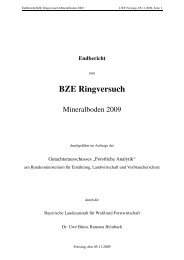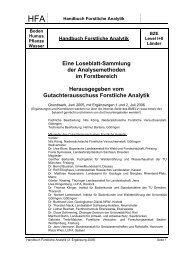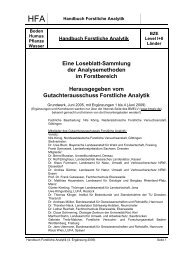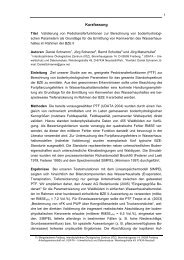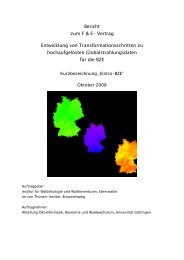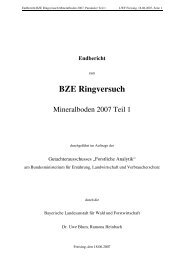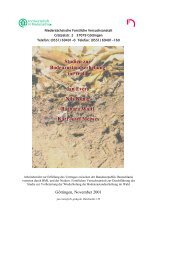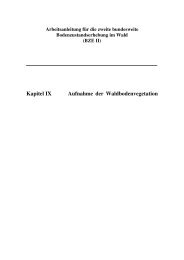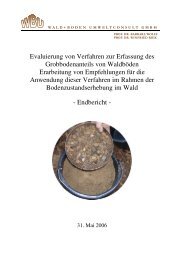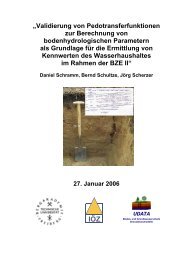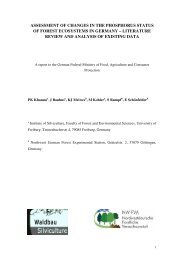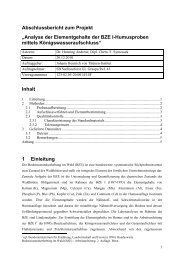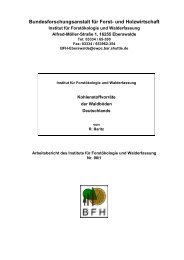assessment of changes in the phosphorus status of forest ...
assessment of changes in the phosphorus status of forest ...
assessment of changes in the phosphorus status of forest ...
Create successful ePaper yourself
Turn your PDF publications into a flip-book with our unique Google optimized e-Paper software.
Below, <strong>the</strong>se hypo<strong>the</strong>ses are be<strong>in</strong>g discussed on <strong>the</strong> basis <strong>of</strong> a critical literature review<br />
<strong>in</strong>clud<strong>in</strong>g data from <strong>the</strong> long-term studies. Moreover, <strong>the</strong>re is very little compiled<br />
<strong>in</strong>formation on <strong>the</strong> use <strong>of</strong> o<strong>the</strong>r plant parts (leaf or needle litter, f<strong>in</strong>e roots) to assess<br />
<strong>the</strong> P nutritional <strong>status</strong> <strong>of</strong> trees, which may be used as a better <strong>in</strong>dicator. There is very<br />
little known <strong>in</strong>formation about <strong>the</strong> consequences on plant growth, decomposer<br />
activity and o<strong>the</strong>r ecosystem functions for various P levels <strong>in</strong> <strong>forest</strong> ecosystems. The<br />
review will consider some <strong>of</strong> <strong>the</strong>m by <strong>in</strong>clud<strong>in</strong>g relevant data from <strong>the</strong> literature.<br />
1.1 Changes <strong>in</strong> P supply <strong>in</strong> <strong>forest</strong> soils due to acidify<strong>in</strong>g <strong>in</strong>puts.<br />
Acidify<strong>in</strong>g <strong>in</strong>puts can decrease <strong>the</strong> plant <strong>phosphorus</strong> <strong>status</strong> (normally observed <strong>in</strong> <strong>the</strong><br />
foliage samples), which is related to acidification and Al toxicity caus<strong>in</strong>g a decrease<br />
<strong>in</strong> P supply <strong>in</strong> soils or reduced P uptake capacity. A number <strong>of</strong> soil processes may be<br />
associated to such <strong>changes</strong> <strong>in</strong> P availability and uptake through <strong>changes</strong> <strong>in</strong> vitality <strong>of</strong><br />
<strong>the</strong> mycorrhizal fungi. Several studies conducted <strong>in</strong> temperate <strong>forest</strong>s have presented<br />
evidence <strong>of</strong> <strong>phosphorus</strong> limitation <strong>in</strong> <strong>forest</strong> stands, where <strong>the</strong> availability <strong>of</strong> nitrogen<br />
was high (B<strong>in</strong>kley and Hogberg 1997; Harrison et al. 1999; Corb<strong>in</strong> et al. 2003; Brown<br />
and Court<strong>in</strong> 2003). High N levels may result from natural or man-made atmospheric<br />
<strong>in</strong>puts or from fertilizer additions for experimental or management reasons.<br />
(a) Natural or man-made <strong>in</strong>puts <strong>of</strong> acidify<strong>in</strong>g substances.<br />
Nihlgard (1985) proposed <strong>the</strong> hypo<strong>the</strong>sis that <strong>forest</strong>s will run <strong>in</strong>to nutrient imbalances<br />
because <strong>of</strong> <strong>in</strong>creased N deposition. Commonly N/P ratios <strong>in</strong> <strong>the</strong> foliage samples are<br />
used to assess <strong>the</strong> imbalances <strong>in</strong> P <strong>status</strong>. An <strong>in</strong>crease <strong>in</strong> N/P ratios <strong>in</strong>dicates an<br />
imbalance ow<strong>in</strong>g to low P uptake under high N <strong>in</strong>put conditions. L<strong>in</strong>der (1995)<br />
suggested that <strong>the</strong> ratios between nutrients are much more important for judg<strong>in</strong>g <strong>the</strong><br />
nutrient <strong>status</strong> than <strong>the</strong> concentrations <strong>the</strong>mselves as <strong>the</strong> concentrations are <strong>in</strong>fluenced<br />
by <strong>the</strong> amount <strong>of</strong> non-structural carbohydrates <strong>in</strong> <strong>the</strong> leaves. Deficiencies <strong>of</strong> P <strong>in</strong><br />
<strong>forest</strong> stands receiv<strong>in</strong>g high levels <strong>of</strong> acidify<strong>in</strong>g atmospheric <strong>in</strong>puts have been<br />
reported <strong>in</strong> North America and Europe. For example, Bernier and Brazeau (1988)<br />
reported P deficiencies <strong>in</strong> sugar maple stands <strong>in</strong> Quebec and Mohren et al. (1986) and<br />
Houdijk and Roel<strong>of</strong>s (1993) <strong>in</strong> <strong>forest</strong>s <strong>in</strong> <strong>the</strong> Ne<strong>the</strong>rlands, especially <strong>in</strong> Douglas fir<br />
stands. Harrison et al. (1999) reported that <strong>in</strong> <strong>the</strong> UK <strong>the</strong> poor canopy condition was<br />
related to P stress <strong>in</strong> beech, Scots p<strong>in</strong>e and Sitka spruce stands. Polle et al. (1992)<br />
reported P deficiency <strong>in</strong> needles <strong>of</strong> three Norway spruce stands grow<strong>in</strong>g at three<br />
11



